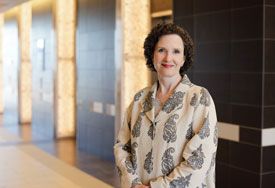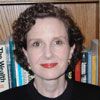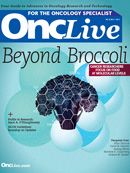Publication
Article
Oncology Live®
Attacking the Frontiers of Breast Cancer: A Conversation With Joyce A. O'Shaughnessy, MD
Author(s):
As a child Joyce Ann O'Shaughnessy enjoyed science and her home chemistry set. Still, she didn't give much thought to pursuing the subject beyond the confines of her school - until she faced a tragedy.

A Conversation With Joyce A. O’Shaughnessy, MD
As a child in Beverly, Massachusetts, Joyce Ann O’Shaughnessy enjoyed science and her home chemistry set. Still, she didn’t give much thought to pursuing the subject beyond the confines of her school—until she faced a tragedy.
After her youngest sister, Teri, was diagnosed with leukemia, 14-year-old O’Shaughnessy demonstrated the seriousness and determination that have since shaped her career as a physician and cancer researcher. Frustrated by her inability to help, the teenager vowed to fight cancer by becoming a doctor.
When Teri died 5 years later, at the age of 10, O’Shaughnessy was a freshman biology student at Holy Cross College in Worcester, Massachusetts. She reacted to the loss by reinforcing her commitment to fight the disease.
“I wanted to immediately start doing research, but as a 19-year-old that wasn’t as common back then,” O’Shaughnessy recalled. “I went to the dean and said, ‘I need to start doing cancer research. Can I do it here, or do I need to transfer to a big university?’ ”
The dean provided funding to support the fledgling researcher, who studied tumor virology and wrote a senior thesis on leukemia before going on to earn a medical degree, cum laude, from Yale University and launching a career devoted to fighting breast cancer.
Since 1997, O’Shaughnessy has worked as a medical oncologist within a practice of more than 400 physicians, Texas Oncology, and has served as co-chair for breast cancer research at US Oncology, a physician practice management company that cares for about 20% of the nation’s cancer population and brings oncologists together to do clinical research. Based in Dallas, O’Shaughnessy is also the Celebrating Women Endowed Chair in Breast Cancer Research at the Baylor- Charles A. Sammons Cancer Center at Baylor University Medical Center.
In the 25 years since she began that first research project, O’Shaughnessy has treated thousands of patients with breast cancer while evaluating new therapeutic strategies to fight the disease. Her accomplishments include designing and leading investigations of capecitabine and gemcitabine, cytotoxic agents that were approved by the FDA about a decade ago and are now among those most widely used in treating breast cancer. O’Shaughnessy also led recent studies of iniparib, a novel drug for patients with metastatic triple-negative breast cancer and other cancers.
“Breast cancer is, in a sense, a very hopeful disease—we have a lot of success in treating breast cancer, and this spurs you on to crack the code of the breast cancers that are not yet curable,” O’Shaughnessy said. “There are many different subtypes, and clinician investigators are working to match patients’ genotypes to the most promising therapies for them.”
Research Snapshot
ONC: You regularly plan and oversee clinical trials designed to improve care for breast cancer patients. What are some of your current projects?
O’Shaughnessy: I’m the principal investigator on a US Oncology trial being done in collaboration with the Translational Genomics Research Institute (TGen) and Life Technologies within which TGen is conducting whole genome sequencing on tissue obtained from metastatic triple negative breast cancer patients.
The objectives of the study are to determine the key driving mutations in these patients’ cancers, and to then refer patients to the appropriate clinical trials to receive treatment with agents that target these key driving mutations. It’s an important effort in that there has been only one patient whose metastatic triple negative breast cancer has been fully sequenced and published, and it is critical that we develop an understanding of the main molecular abnormalities in these aggressive cancers.
In addition, I’m serving as a co-investigator in a US Oncology trial known as the TC-TAC trial. TAC is a standard chemotherapy regimen for high-risk early breast cancer patients: docetaxel (Taxotere), doxorubicin (Adriamycin), and cyclophosphamide (Cytoxan). But for HER2-negative breast cancer, which is this trial’s focus, we really don’t know if patients need the doxorubicin, which can cause congestive heart failure and leukemia. We’re conducting this large randomized phase III trial to try to answer the question of whether doxorubicin is needed in treating ER or triple negative breast cancers. If the answer is no, we can give patients the same chemotherapy regimen without doxorubicin and get equally good results with less toxicity.
Leading Groundbreaking Trials
During a typical week, O’Shaughnessy discusses the design of diagnostic and therapeutic studies with clinical research specialists across the country, considering: biologic mechanisms; which patients, and with which forms of breast cancer, should be included in trials; and whether compounds should be tested as single agents or in combination with other treatments. After helping to develop new agents for the treatment of metastatic breast cancer, O’Shaughnessy often works to bring the therapies to patients with less-advanced forms of the disease, in the preoperative or adjuvant setting.
O’Shaughnessy also spends 2 days a week treating breast cancer patients while peppering her schedule with visits to research, investigator, and advisory meetings, and medical conferences, along with opportunities to teach practicing medical oncologists.
“It’s what I want to do,” O’Shaughnessy said. “I’ve chosen not to dedicate time now to hobbies that could be otherwise dedicated to pushing back the frontiers of breast cancer. I really love it, and I wouldn’t want it any other way.”
More than a decade ago, O’Shaughnessy made signifi cant contributions to breast cancer care by helping to design and oversee clinical trials for gemcitabine (Gemzar) and capecitabine (Xeloda), leading to FDA approval of the drugs that have improved outcomes for many breast cancer patients. The treatments, part of a class of cytotoxic agents called antimetabolites, which stop the growth of cancer cells by preventing the production of DNA and RNA, are also used in other types of cancer, and are being investigated in early breast cancer.
Over the years, the researcher was also involved in the original clinical trials of paclitaxel (Taxol), a mitotic inhibitor; FLAC chemotherapy (treatment with a combination of 5-fl uorouracil, leucovorin, doxorubicin, and cyclophosphamide); a combination of lapatinib and trastuzumab to treat metastatic HER2-positive breast cancer; and bevacizumab (Avastin), which she believes should remain a treatment option for metastatic breast cancer patients, despite a 2010 recommendation by the FDA that the breast cancer indication be eliminated from the Avastin label.
Recently, O’Shaughnessy has been at the hub of another groundbreaking project, serving as lead investigator in clinical trials of iniparib. The initial trial caused excitement because of the proposed cutting-edge mechanism of the targeted treatment, which is thought to work by inhibiting PARP, or poly (ADP-ribose) polymerase, leaving cells unable to repair DNA after they are hit by chemotherapy.
“Synthetic lethality is the concept,” O’Shaughnessy said. “You figure out from a synthetic standpoint what problem the cancer already has, and what therapeutic inhibitor you can add to cause a lethal event. The preliminary data from PARP inhibitor trials have launched a new field of research.”
Making a Mark With Iniparib
O’Shaughnessy’s initial iniparib trial also drew attention within the oncology community because it tested the drug’s potential in patients with triple-negative breast cancer (TNBC), a condition that accounts for 15% to 20% of all breast cancers and is associated with poorer outcomes. TNBC arises when tumors lack receptors for estrogen or progesterone and do not overexpress the protein HER2. That makes hormonal therapies such as tamoxifen and targeted therapies such as Herceptin ineffective, leaving chemotherapy as the standard treatment.
In a phase II study, the results of which were announced in June 2009, O’Shaughnessy reported that treatment with iniparib, in combination with gemcitabine and carboplatin, significantly improved overall survival in women with metastatic TNBC.
But in early 2011, the confirmatory phase III trial results showed that while iniparib benefited TNBC patients in the second- and third-line settings, it had not brought about anticipated increases in overall and progression-free survival in patients receiving fi rst-line therapy, nor in the overall population.
“It’s a puzzle to us at this time why we did not see that same big benefit in first-line patients,” O’Shaughnessy said. “We’re doing clinical and biomarker analyses to understand the patient populations in the two trials to see if there are differences, so the way forward is under very active discussion. It’s planned that there will be additional studies to follow up on this phase III trial in breast cancer. We are very committed to finding out who benefits and who doesn’t, and doing trials specifically in those patients we believe will benefit.”
Ultimately, O’Shaughnessy anticipates that iniparib—also being studied in patients with squamous non-small cell lung cancer, breast, brain, and other cancers—will be helpful for a specific group of breast cancer patients.
Similarly, O’Shaughnessy believes that capecitabine, when studied further, will turn out to be most useful in earlystage patients with rapidly growing breast cancers—despite the drug’s failure, last year, to meet all its endpoints in an adjuvant trial of patients with high-risk early breast cancer.
“If we can prove it, the capecitabine and iniparib trials may demonstrate that a drug can benefit specific patient subgroups even if a study of all patients combined has negative results,” O’Shaughnessy said. “This will help change the treatment paradigm in the sense that, increasingly, we are understanding that these treatments do not work for all patients with breast cancer, since there are several major kinds.”

Joyce A. O’Shaughnessy At a Glance
- Is married; her husband Ed is an attorney
- Has 2 children: 20-year-old Mark, a sophomore at Stanford University, and 18-year-old Tess, a freshman at Princeton University. The two made it into top schools because “we’re hardworking in our family,” O’Shaughnessy said. “The kids are tired of hearing me say that hard work is its own reward.”
- Enjoys visiting her parents, sisters, and extended family in Boston and coastal New Hampshire several times each year
- In 1982, won the Francis Parker Award at Yale Medical School, meaning she was the faculty’s choice for Most Promising Clinician
- Serves as the Celebrating Women Endowed Chair in Breast Cancer Research at Baylor University Medical Center, in Dallas
- Is a member of the oncology advisory boards for J&J, Lilly, GSK, Genentech, Caris Diagnostics, Boehringer Ingelheim, Novartis, BMS, Enzon, and Sanofi
- Sees a trend toward clinical trials becoming smaller and more numerous, due to the growing need to treat specifi c cancer subtypes. The trials will require more central and practice infrastructure, she expects, but will bring greater clinical benefit and scientific insight
- Believes it is crucial for the government to prioritize funding of oncology research and development, despite economic constraints and healthcare reform laws. “Restricting research and development at this time would be to not realize the return on the enormous investment that has been made in cancer science, given the explosive pace of discovery going on in molecular diagnostics and targeted therapeutics,” she said.
Melding Practice and Research
It was early in her career when O’Shaughnessy realized she had a penchant for deciphering the puzzles presented by disease. As a senior at Holy Cross, she was chosen as Fenwick Scholar, entitling her to spend her senior year conducting independent research. Working at the Worcester Foundation for Experimental Biology, O’Shaughnessy studied ultrastructural analysis of human and mouse leukemia.
“I had a lot of time to read in the library and try to think through problems in tumor virology,” the researcher recalled. “Still, to this day, that’s what I like to do best—read a lot of cancer biology data and try to connect the dots, thinking about my patients’ specific breast cancers.”
When O’Shaughnessy left Yale, she didn’t immediately have the opportunity to use those skills. Her internship and residency in Internal Medicine at Massachusetts General Hospital didn’t leave time for research.
Later, as a medical oncology fellow at the National Cancer Institute (NCI) in Bethesda, Maryland, O’Shaughnessy experienced the opposite extreme: She researched to her heart’s content, but had limited patient contact after the clinical training years.
“Practice is extremely rewarding to me, and I can’t imagine not doing it,” she refl ected. “It’s extremely rewarding to be an individual woman’s advocate, bringing research to her, and making sure she’s getting the best, including the best clinical trials. Also, that’s where you learn all about the disease. There’s no substitute for being there with the patients and seeing which therapies they respond to and matching their natural history phenotypes to their genotypes.”
Wanting to combine her interests, O’Shaughnessy decided to stay at NCI but pursue clinical and translational research. In 1990, 5 years into her experience there, O’Shaughnessy took a position offered to her by Ken Cowan, MD, PhD, in the Medicine Branch breast cancer research program, and realized she’d found her niche.
“That brought it all together for me,” she recalled. “It involved clinical and translational science, patient care, teaching, and working with scientists in the lab. It crystallized exactly what I wanted to do.”
Her current roles offer a similar mix, allowing O’Shaughnessy to “be part of the team of oncologists around the world that are putting together novel combinations of key pathway inhibitors in breast cancer,” she said. “We need to move toward evaluating triplet combinations of pathway inhibitors, and that means understanding individual cancers and the key pathways driving them.”
Along the way, O’Shaughnessy hopes to spare patients and their families the helplessness she and her family experienced during her sister’s battle with cancer.
“In addition to my sister’s cancer battle, I made the decision to pursue oncology because I thought that the pathogenesis of malignancy would come to be understood during my lifetime,” O’Shaughnessy said. “I very much wanted to see this unfold, and my expectations are being surpassed.”







.jpg?fit=crop&auto=format)
